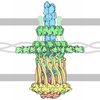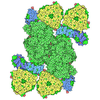+ Open data
Open data
- Basic information
Basic information
| Entry | Database: PDB / ID: 9g8s | ||||||
|---|---|---|---|---|---|---|---|
| Title | C3 reconstruction of extended phiCD508 needle | ||||||
 Components Components |
| ||||||
 Keywords Keywords | VIRUS / Bacteriophage / needle / baseplate | ||||||
| Function / homology |  Function and homology information Function and homology informationvirus tail, sheath / symbiont genome ejection through host cell envelope, contractile tail mechanism / viral tail assembly / membrane Similarity search - Function | ||||||
| Biological species |  Clostridioides phage phiCD508 (virus) Clostridioides phage phiCD508 (virus) | ||||||
| Method | ELECTRON MICROSCOPY / single particle reconstruction / cryo EM / Resolution: 3.96 Å | ||||||
 Authors Authors | Wilson, J.S. / Fagan, R.P. / Bullough, P.A. | ||||||
| Funding support |  United Kingdom, 1items United Kingdom, 1items
| ||||||
 Citation Citation |  Journal: Life Sci Alliance / Year: 2025 Journal: Life Sci Alliance / Year: 2025Title: Molecular mechanism of bacteriophage contraction structure of an S-layer-penetrating bacteriophage. Authors: Jason S Wilson / Louis-Charles Fortier / Robert P Fagan / Per A Bullough /   Abstract: The molecular details of phage tail contraction and bacterial cell envelope penetration remain poorly understood and are completely unknown for phages infecting bacteria enveloped by proteinaceous S- ...The molecular details of phage tail contraction and bacterial cell envelope penetration remain poorly understood and are completely unknown for phages infecting bacteria enveloped by proteinaceous S-layers. Here, we reveal the extended and contracted atomic structures of an intact contractile-tailed phage (φCD508) that binds to and penetrates the protective S-layer of the Gram-positive human pathogen The tail is unusually long (225 nm), and it is also notable that the tail contracts less than those studied in related contractile injection systems such as the model phage T4 (∼20% compared with ∼50%). Surprisingly, we find no evidence of auxiliary enzymatic domains that other phages exploit in cell wall penetration, suggesting that sufficient energy is released upon tail contraction to penetrate the S-layer and the thick cell wall without enzymatic activity. Instead, the unusually long tail length, which becomes more flexible upon contraction, likely contributes toward the required free energy release for envelope penetration. | ||||||
| History |
|
- Structure visualization
Structure visualization
| Structure viewer | Molecule:  Molmil Molmil Jmol/JSmol Jmol/JSmol |
|---|
- Downloads & links
Downloads & links
- Download
Download
| PDBx/mmCIF format |  9g8s.cif.gz 9g8s.cif.gz | 4.7 MB | Display |  PDBx/mmCIF format PDBx/mmCIF format |
|---|---|---|---|---|
| PDB format |  pdb9g8s.ent.gz pdb9g8s.ent.gz | Display |  PDB format PDB format | |
| PDBx/mmJSON format |  9g8s.json.gz 9g8s.json.gz | Tree view |  PDBx/mmJSON format PDBx/mmJSON format | |
| Others |  Other downloads Other downloads |
-Validation report
| Summary document |  9g8s_validation.pdf.gz 9g8s_validation.pdf.gz | 1.5 MB | Display |  wwPDB validaton report wwPDB validaton report |
|---|---|---|---|---|
| Full document |  9g8s_full_validation.pdf.gz 9g8s_full_validation.pdf.gz | 1.5 MB | Display | |
| Data in XML |  9g8s_validation.xml.gz 9g8s_validation.xml.gz | 267.4 KB | Display | |
| Data in CIF |  9g8s_validation.cif.gz 9g8s_validation.cif.gz | 429.4 KB | Display | |
| Arichive directory |  https://data.pdbj.org/pub/pdb/validation_reports/g8/9g8s https://data.pdbj.org/pub/pdb/validation_reports/g8/9g8s ftp://data.pdbj.org/pub/pdb/validation_reports/g8/9g8s ftp://data.pdbj.org/pub/pdb/validation_reports/g8/9g8s | HTTPS FTP |
-Related structure data
| Related structure data |  51138MC  9gayC  9gazC  9gb0C  9gb1C  9gb2C  9gb3C  9gb4C  9gb5C  9gb6C  9gb7C  9gb8C M: map data used to model this data C: citing same article ( |
|---|---|
| Similar structure data | Similarity search - Function & homology  F&H Search F&H Search |
- Links
Links
- Assembly
Assembly
| Deposited unit | 
| ||||||||||||||||||||||||||||||||||||
|---|---|---|---|---|---|---|---|---|---|---|---|---|---|---|---|---|---|---|---|---|---|---|---|---|---|---|---|---|---|---|---|---|---|---|---|---|---|
| 1 |
| ||||||||||||||||||||||||||||||||||||
| Noncrystallographic symmetry (NCS) | NCS domain:
|
 Movie
Movie Controller
Controller














 PDBj
PDBj









